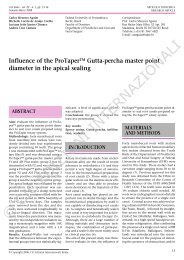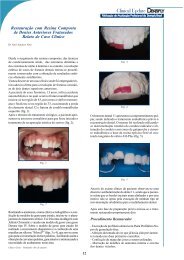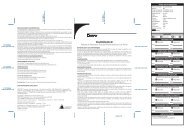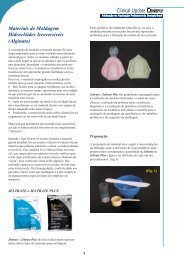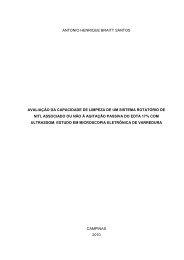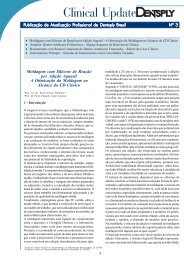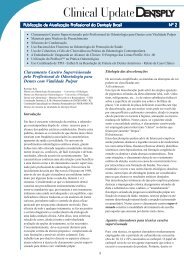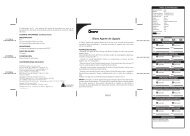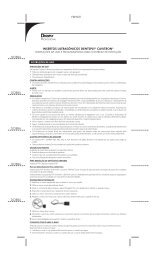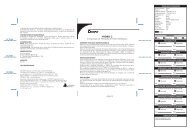You also want an ePaper? Increase the reach of your titles
YUMPU automatically turns print PDFs into web optimized ePapers that Google loves.
Adhesive Luting Revisited: Influence of Adhesive,<br />
Temporary Cement, Cavity Cleaning, and Curing Mode<br />
on Internal Dentin Bond Strength<br />
Roland Frankenberger a /Ulrich Lohbauer b /Michael Taschner c /Anselm Petschelt d /<br />
Sergej A. Nikolaenko e<br />
Purpose: To evaluate microtensile bond strength to Class I cavity floor dentin beneath adhesive inlays that were luted<br />
with different adhesives, temporary cements, cleaning methods, and curing modes.<br />
Materials and Methods: Occlusal cavities (4 x 4 mm, depth 3 mm) were prepared in 96 extracted human third molars.<br />
One part of the cavities was temporized with different temporary cements, which were removed after one week<br />
using three techniques (scaler or air polishing with Prophypearls or ClinPro powder). Direct resin composite inlays<br />
(Clearfil AP-X) were then placed with the luting composite Calibra using three adhesives (XP BOND/SCA, Syntac, Opti-<br />
Bond FL). Teeth were cut into beams and after 24 h of water storage at 37°C, the sticks were subjected to microtensile<br />
bond strength evaluation. Samples were subjected to SEM fractographic analysis of failed interfaces.<br />
Results: Contamination with temporary cement reduced dentin bond strengths (p < 0.05). Removing remnants of cements<br />
with Prophypearls air polishing resulted in the lowest bond strengths (p < 0.05). Separate light curing of the adhesives<br />
did not produce higher dentin bond strengths (p > 0.05). Syntac still worked when Heliobond was omitted (p ><br />
0.05). Immediate dentin sealing prior to temporizing increased internal bond strength (p < 0.05).<br />
Conclusion: The dual-cured adhesive provided higher internal bond strengths between adhesive inlays and dentin. Contamination<br />
of dentin with temporary cements is a hazard for excellent dentin adhesion of adhesive inlays. Therefore, immediate<br />
dentin sealing and resin coating is promising.<br />
Keywords: etch-and-rinse, dentin bonding, adhesive inlays, microtensile bond strength.<br />
J Adhes Dent 2007; 9: 269-273. Submitted for publication: 15.12.06; accepted for publication: 5.1.07.<br />
a Associate Professor, Dental Clinic 1, Operative Dentistry and Periodontology,<br />
University of Erlangen-Nuremberg, Erlangen, Germany.<br />
b Assistant Professor, Dental Clinic 1, Operative Dentistry and Periodontology,<br />
University of Erlangen-Nuremberg, Erlangen, Germany.<br />
c Assistant Professor, Dental Clinic 1, Operative Dentistry and Periodontology,<br />
University of Erlangen-Nuremberg, Erlangen, Germany.<br />
d Professor and Chairman, Dental Clinic 1, Operative Dentistry and Periodontology,<br />
University of Erlangen-Nuremberg, Erlangen, Germany.<br />
e Professor and Head, Department of Operative Dentistry, Krasnojarsk State<br />
Medical Academy, Krasnojarsk, Russia.<br />
Paper presented at Satellite Symposium on Dental Adhesives, Dublin,<br />
September 13th, 2006.<br />
Reprint requests: Prof. Dr. Roland Frankenberger, Dental Clinic 1, Operative<br />
Dentistry and Periodontology, University of Erlangen-Nuremberg, Glueckstrasse<br />
11, D-91054 Erlangen, Germany. Tel: +49-9131-853-3693, Fax: +49-9131-853-<br />
Adhesive inlays have proven to be durable in the oral cavity.<br />
4,6,15,18,19,24,25,27,28 Clinical reports refer to bulk fractures<br />
as the main failure reason for all ceramic inlay systems.<br />
8-10,15,18,19,26 Clinical trials focusing on ceramic inlays<br />
reveal a certain deterioration of marginal quality; 7 however,<br />
when adhesive inlays are totally bonded to enamel and<br />
dentin, internal dentin bond strength is also an interesting<br />
factor for both stabilization and reduction of postoperative<br />
hypersensitivity. 14,15,20<br />
It is still not fully understood which mode of luting is most<br />
reliable for bonding adhesive tooth-colored inlays to enamel<br />
and dentin, but conventional etch-and-rinse systems with<br />
dual-cured resin composites seem to be the gold standard<br />
for luting. 1,15,18,20,16<br />
Therefore, the aim of the present in vitro study was to evaluate<br />
the performance of different etch-and-rinse adhesives<br />
Vol 9, Supplement 2, 2007 269



